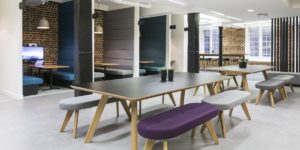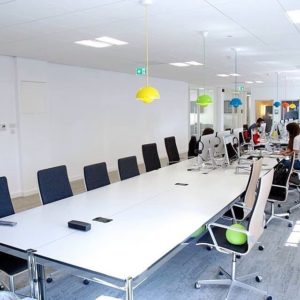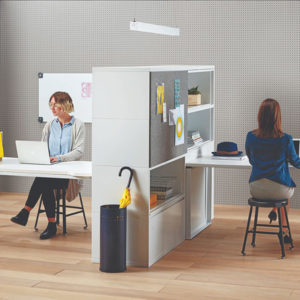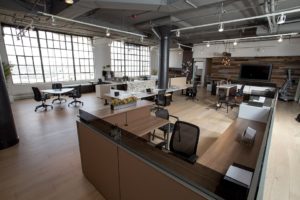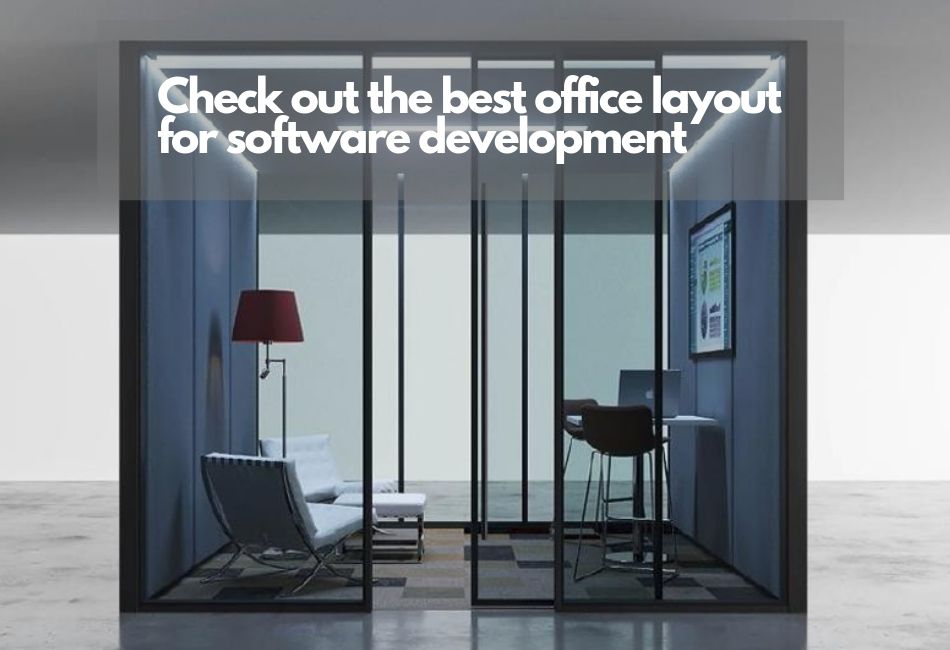The best office layout for software development is based on productivity and not many distractions. Developers need 125 sq.ft. in cubicles. Open space layouts require the same square feet. Conference rooms can accommodate up to 20 software developers based on a layout of 15 X 25 sq ft.
These terms are general and they can vary considerably. However, modern office layouts are linear and they are made according to well-defined standards. Depending on the available space, software development office layouts could be based on the following models.
Cubicles
Employers love cubicles because they are easy to assemble and they are cheap to set up. However, they can feel the isolation for some developers.
Pros
- Suitable for large software companies
- Allows simple setup
- Can be split into various teams
- Made for a bit more privacy
Cons
- Promotes too many people in small spaces
- Multiple teams can create higher noise levels
Software development clusters
Clusters are similar to cubicles but without the physical barriers. They are great for communication and teamwork on the same project.
Pros
- Improves communication
- Allows software developers to communicate quickly
- Best for teams which need to discuss projects often
Cons
- Eliminates the benefit of meetings as all team members already sit together
Open space
Open spaces are the norm for many IT companies. They improve communication between employees and they are cheap to set up.
Pros
- Fast setup
- Can incorporate development, marketing, and other teams together
- Improves communication between employees
- Best for unobstructed natural light
Cons
- Needs support with private meeting rooms
- Can be noisy for some developers
Private rooms
Developers who are constantly on the phone with clients need their own private space. The private room office layout is not dead and it’s only going to get stronger.
Pros
- Stimulates concentration
- Best for developers who prefer working on their own
- Creates a good space for frequent calls and meetings
Cons
- Requires extra floor space
- Should be backed by common spaces for team members interaction
Co-working spaces
Co-working spaces are among the newer options for software developers with a higher sense of freedom. Freelancers find it particularly appealing.
Pros
- Improves networking
- Allows various working locations on the same floor
- Best for freelancers
- Includes small phone booths
Cons
- Lack of privacy
- May lack stability for software development teams
Why do software developers need to work in open spaces and not on their own?
Apart from working in clusters, software developers might even be facing an unexpected reaction to open space working. This office layout has already been proven to reduce face to face interaction and replace it with instant messaging communication.
A 2018 study shows that open office layouts, open office spaces stimulate electronic means of communication. All of this happens while real face-to-face interaction decreases. But this study goes even further and it tells something many software developers and their managers are unaware of. Up to 70% of the face-to-face interactions are reduced in open office layouts. Electronic messaging such as chat and e-mail increase between 20% and 50%. The real question to be asked is how important is real face-to-face interaction in a software development team?
Actionable office layout tips for software development
This being said, there are a few specific and a few general tips which can help the office atmosphere of a software development team.
Start with better gear (desks, standing desks, better office chairs, better computer mouses, headphones, etc.)
- Limit time spent in isolation
- Find best display options (multiple monitors)
- Create a kitchen area
- Install extra power sockets
- Limit the use of artificial light and favor natural light
- Allow developers to choose between laptops and computers
- Create a zone for individual work, use separators if needed
- Create a space for relaxation
- Choose furniture according to what developers like
- Test different office temperatures
- Declutter as often as possible
- Test out noise levels
- Consider adding some type of plants
- Test out various office layouts for a few weeks
- Consider the cleanliness of the office and how it can be improved
- Minimize exterior distractions such as traffic noise by installing double glazed windows
- Invest in ergonomic furniture which can support the minimum of 8 hours per day in the office
- Don’t force introverts to sit in crowded areas
- Don’t force extroverts to work in isolation
- Organize a space for meetings which supports presentations
- Considering going wireless on all gear which supports it
- Create a clothes hanger and stop coats being placed on chairs
The type of gear which requires most room in an office where software developers work
A few technical solutions require a bit of extra room in an office layout of software developers. Python, Ruby or JavaScript lines can often be presented and analyzed via a projector, for learning purposes. The same can apply for any other presentation or study cases. A projector should ideally be placed in a conference room. Office layouts with no conference room should place the projector at an angle in which it can be viewed from the cluster layout the best.
Other gear which needs to be accessible includes printers. Most developers rarely use them and this is why a single wireless printer is connected to all computers and it should be part of a layout in which it is placed in a common area.
Remote or freelance software developer office layout
Working as a freelance software developer often means working from home is a reality. In this case, the options for the best office layout are limited. There is not as much space as on commercial premises and making the most out of small spaces is a must.
Instead of listing the obvious elements needed in a home office for developers, we’re only going to look at a few top solutions to be used at home for maximum productivity, which might not be as obvious.
- A whiteboard
Whiteboards can serve as real physic reminders and organizer. Simply staying organized and knowing which project is due on a certain week and having a list of prioritized clients can help a developer considerably. Unlike electronic reminders, anything written on a whiteboard is visible at all times.
- Stick-on desktop whiteboard
A stick-on desktop whiteboard is a complementary solution to work on something more urgent, such as a coding problem. Writing it down can help visualize the problem better. Such whiteboards with a stick-on profile can be placed directly on the desk. At the same time, these boards can be wiped quickly.
If it sounds like a lot of work, just look at why productivity and satisfaction are impacted by the office layout
There are a few general points to make when it comes to office layout and software development. Luckily, we have another study to look at and its findings show the various benefits and the various drawbacks of the open office layout style, which is now popular with many companies.
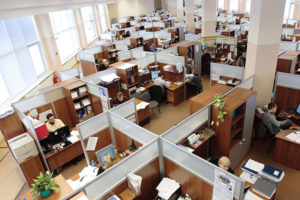
Benefits
According to a 2016 study on office design and its impact on teamwork, there are a few conclusions which can be at the root of any new layout.
- Better communication with non-team colleagues
One of the benefits of working in an office space where everybody is not together is that developers can increase their cooperation with other team members. In terms of immediate productivity, this most not mean much. However, it can still help them better understand each project and product as a whole, making an effort to deliver a result which all teams are striving for.
- New contacts in other teams
An open office layout where there are no clusters can also increase the chances of meeting colleagues from other teams. This has been shown to happen in this study and many can see this as a considerable advantage.
Drawbacks
Increased digital communication shortly replaces actual conversations with colleagues. Since non-verbal communication is more important than verbal communication, software developers can lose a lot for not being able to communicate directly.
- Physical distance and visibility of team partners
All the subjects of the study said that the larger the physical distance from colleagues was, the more difficult it was to relate to them. Values such as communication, cooperation, and even trust seemed to be affected the most.
As a result, those who might plan offices for developers working on the same project should find the best methods to keep team members closer.
16% of the study’s subjects said that not being able to sit closers to their colleagues led to poorer cooperation. Even communication increases via messaging and via phone calls, it is still not enough to replace actual face to face communication.
Final considerations
While there is an increasing number of tips on how to improve an office layout, the information might still not be conclusive the real-world situations. The 125 square feet cubicles can mean nothing in real life if they are not backed by some type of benefits in terms of how developers work and in terms of how they feel.
Most studies in the field show these two directions cannot be separated. But are they true in your case? Let us know in the comments below. Before leaving this page, feel free to have a look at a few best office layouts for software developers to get some ideas of what is being used at this moment.
Examples of office layouts and why they can work for software development
